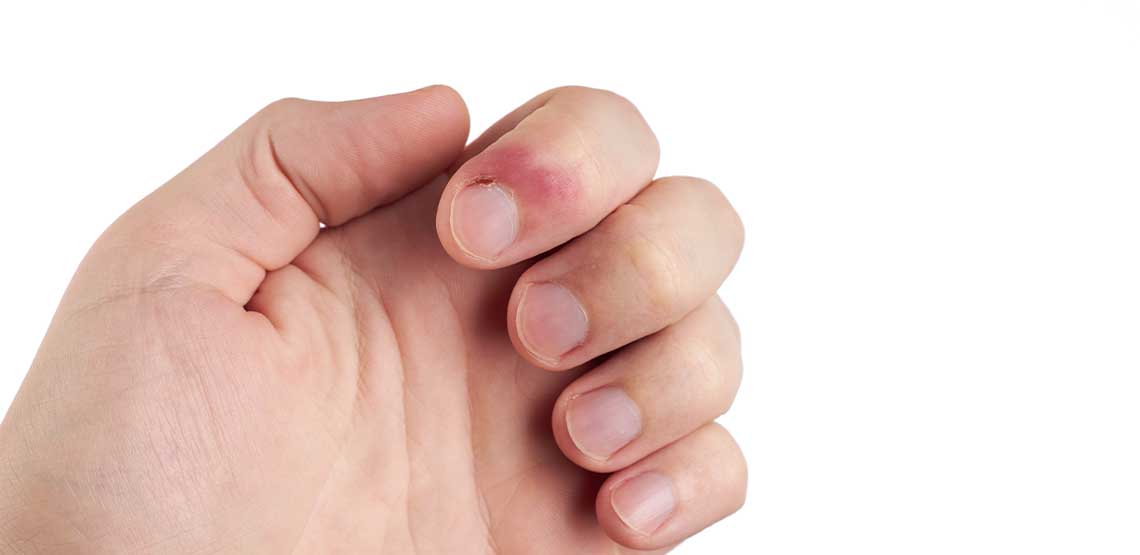Infected Hangnail Treatment
You’ve probably noticed those bothersome pieces of skin on the side of your nails and wondered what they were. Those small bits of skin jutting out from the side of the nail beds have a funny name. Although they are really not nails and are part of the skin, they are called “hangnails", and sometimes they can become infected when we try to remove them. In this article we talk about infected hangnail treatment options so you can get rid of the pain quickly.
What Causes Hangnails?
Hangnails are a common nuisance that everyone experiences from time to time. These tiny slivers can become bothersome, as they can ruin manicures and snag on clothing. Hangnails occur when a portion of the skin located at a nailbed’s edges tear off, usually due to dry, cracked skin. When skin becomes dry from the weather, repeated hand washing, exposure to chemicals, or injury, the skin can break and tear away, creating a hangnail. Hangnails mainly affect hands and very rarely happen on feet.
Workers in select occupations are more prone to developing hangnails. For example, doctors and nurses wash their hands many times a day, making their hands dry. Farmworkers and carpenters also experience frequent hangnails from small injuries.
Though common, hangnails are not usually any cause for concern. They may bleed and feel a little tender, but they typically heal on their own without the need for any treatments. As small and unassuming as they may be, hangnails can become more than just annoying; they can become infected.
How Does a Hangnail Become Infected?
Viruses and bacteria are, quite literally, everywhere. Most people do not think about how many germs their hands are exposed to each day while they go about their business. Elevator buttons, cell phones, and light switches, for example, are touched frequently and can harbor a large number of bacteria.
Good hand hygiene prevents the bacteria from finding their way into our bodies. Unfortunately, sometimes good handwashing is not enough to prevent germs from causing problems. In the case of hangnails, infections are more likely to occur because they expose vulnerable skin tissue.
Symptoms of a Hangnail Infection
Bacterial infections show up quickly, while fungal infections develop gradually. Fungal infections, however, occur more often in people who expose their hands frequently to water or have diabetes.
When a hangnail becomes infected, the signs are easy to spot. Paronychia, the formal name used for a skin infection located near the nail area, can result in the following symptoms:
- Pain surrounding the hangnail
- Red and inflamed skin around the area
- Skin that is warm or hot to the touch
- Pus near the hangnail or nail bed
- Fever
Despite being tiny, a hangnail infection can spread to other parts of the body. If the infection spreads, a person might feel fever, chills, and general fatigue. It’s essential to monitor hangnails for signs of infection and treat them when they occur.
Treatment of a Hangnail Infection
For most hangnail infections, home treatments are sufficient enough to heal the area. Home treatments may include the following options.
Trimming the Hangnail
Cutting the hangnail as close to the base as possible keeps it from snagging on anything and further pulling the hangnail down, which risks further injury and infection. Trimming the hangnail shorter can also decrease the weight pulling down on the area, reducing pain. Remember to clean any nail trimmers before and after use on the site.
Soak in Warm Water
Infected material and wastes can build up in the hangnail area. Cleansing and soaking the infected hangnail about two to three times a day keeps the area clean and increases blood flow.
Moisturize
Moisturizing the area with a mild lotion keeps the skin from drying out and cracking further. Avoid harsh chemicals or perfumes, as they can aggravate the pain and infection.
Medicated Creams and Lotions
Apply over-the-counter antibiotic or antifungal creams as directed on the manufacturer product packaging. These medicated treatments treat the infections and reduce inflammation.
When to See a Doctor
People rarely need to see a physician for an infected hangnail, but it does happen. If left untreated, severe infections can spread to other parts of the body, like tendons, bones, and other organs. Consult with a physician or your licensed healthcare professional if:
- The nail becomes discolored or misshapen due to the infection
- Pus begins to accumulate around and under the nails
- A persistent fever occurs
- You are diagnosed with diabetes
- The area of redness starts to spread up the infected finger
- Infected hangnail symptoms last seven days or more
How to Prevent Hangnails and Hangnail Infections
Preventing hangnails is the first step to avoiding a hangnail infection. To keep hangnails from forming:
- Maintain a dry and clean environment for your hands and feet.
- Use gloves when working with harsh chemicals, water, or objects that can injure hands.
- Manicure nails gently. Pushing back cuticles can cause hangnails for form.
- Disinfect nail products, like clippers, before and after use.
- Avoid habits like nail-biting or picking at dry skin.
- Use moisturizer and cuticle oil frequently.
- People who have diabetes may have a higher risk of developing skin infections. It’s crucial to adhere to treatments and keep blood sugar at a normal range.
